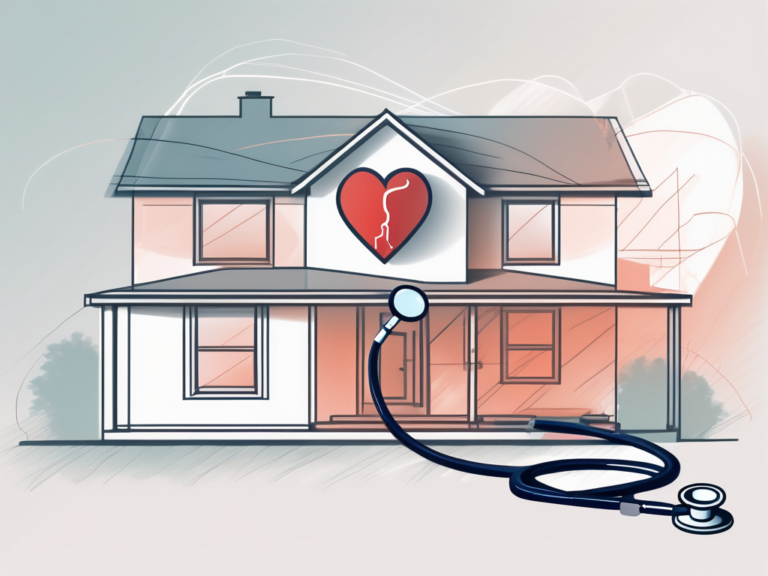Heart, Home and Abducens Nerve
Having a healthy heart and a well-functioning nervous system are crucial for overall well-being. The connection between the heart and the nervous system, specifically the abducens nerve, is an area of interest in medical research. Understanding the anatomy, function, and potential disorders of the abducens nerve can provide valuable insights into maintaining a healthy heart. Additionally, creating a heart-healthy home environment and implementing preventive measures can contribute to the overall well-being of both the heart and the abducens nerve. In this article, we will explore these topics in detail.
Understanding the Abducens Nerve
The abducens nerve, also known as cranial nerve VI, is responsible for controlling the movement of the lateral rectus muscle in the eye. This muscle allows us to move our eyes laterally, facilitating our ability to look from side to side. The abducens nerve originates in the pons region of the brainstem and travels through the cavernous sinus before innervating the lateral rectus muscle of each eye.
Anatomy of the Abducens Nerve
The abducens nerve consists of motor fibers that arise from the abducens nucleus in the pons. From there, it travels through the skull base via the superior orbital fissure and enters the orbit. Within the orbit, it splits into branches that innervate the lateral rectus muscle. While the abducens nerve is relatively short, its role in eye movement is crucial for maintaining normal visual function.
Function of the Abducens Nerve
The primary function of the abducens nerve is to control the lateral rectus muscle, allowing for abduction of the eye. When the abducens nerve is functioning properly, our eyes can smoothly move laterally, enhancing our visual field and facilitating our ability to focus on objects in different directions.
Common Disorders of the Abducens Nerve
Like any nerve in the body, the abducens nerve can be affected by various disorders. One common disorder is abducens nerve palsy, which occurs when the nerve’s function is impaired, leading to the inability to fully or partially abduct the eye. This condition can result from traumatic injuries, infections, tumors, or other underlying medical conditions.
Another disorder is abducens nerve compression, which can occur when adjacent structures compress or exert pressure on the nerve. This compression can lead to similar symptoms as abducens nerve palsy, including difficulty moving the eye laterally.
Furthermore, there are cases where the abducens nerve can be affected by inflammation, such as in cases of autoimmune diseases like multiple sclerosis. In these instances, the body’s immune system mistakenly attacks the protective covering of the nerve, leading to its dysfunction. This can result in various visual disturbances, including double vision and difficulty coordinating eye movements.
In rare cases, the abducens nerve can also be affected by congenital abnormalities, where individuals are born with structural or functional abnormalities in the nerve. These abnormalities can range from mild to severe and may require medical intervention to improve eye movement and visual function.
The Heart: Our Vital Organ
The heart is an incredible organ that plays a fundamental role in sustaining life. Functioning as a pump, it circulates oxygenated blood to all parts of the body, delivering vital nutrients and removing waste products. Understanding the structure of the heart and its role in circulation is essential for comprehending its connection with the abducens nerve.
Structure of the Heart
The heart is composed of four chambers: two atria and two ventricles. The atria receive blood returning to the heart, while the ventricles pump blood out to the body. This intricate design allows for efficient circulation and ensures that oxygen-rich blood is delivered to every cell in the body. Additionally, the heart is surrounded by a protective sac called the pericardium and is supported by a network of blood vessels called coronary arteries, which supply oxygen and nutrients to the cardiac muscle.
Within the chambers of the heart, there are valves that regulate the flow of blood. These valves ensure that blood flows in one direction, preventing any backflow or leakage. The tricuspid valve separates the right atrium from the right ventricle, while the mitral valve separates the left atrium from the left ventricle. The pulmonary valve controls the flow of blood from the right ventricle to the lungs, and the aortic valve allows blood to exit the left ventricle and enter the aorta, the body’s largest artery.
The Heart’s Role in Circulation
The heart’s pumping action facilitates systemic circulation, supplying oxygenated blood to organs, tissues, and cells throughout the body. As blood leaves the heart, it travels through arteries, which progressively branch into smaller vessels called arterioles and then capillaries. In capillaries, the exchange of oxygen, nutrients, and waste products occurs. This exchange is vital for the proper functioning of cells and ensures that they receive the necessary resources to carry out their functions.
Once the exchange has taken place in the capillaries, the deoxygenated blood then returns to the heart through veins. This marks the beginning of the process of pulmonary circulation, where the blood is transported to the lungs to be oxygenated before returning to the heart to be recirculated. The heart works tirelessly to maintain this continuous cycle of oxygenation and circulation, ensuring that every part of the body receives the necessary resources to thrive.
Maintaining a Healthy Heart
Promoting heart health involves adopting a healthy lifestyle that encompasses regular physical activity, a balanced diet, and stress management. Engaging in exercise helps strengthen the heart, improve circulation, and maintain a healthy weight. It also promotes the growth of new blood vessels, enhancing the heart’s ability to deliver oxygen and nutrients to the body’s tissues.
A diet rich in fruits, vegetables, whole grains, and lean proteins provides essential nutrients and supports heart function. These foods are packed with vitamins, minerals, and antioxidants that help reduce inflammation, lower cholesterol levels, and maintain healthy blood pressure. Additionally, incorporating omega-3 fatty acids, found in fatty fish like salmon and mackerel, can further protect the heart by reducing the risk of heart disease and arrhythmias.
Stress reduction techniques, such as meditation or engaging in hobbies, can also contribute to heart health by minimizing the negative impact of chronic stress on the body. Stress has been linked to an increased risk of heart disease, as it can raise blood pressure, promote inflammation, and lead to unhealthy coping mechanisms like overeating or smoking. Taking time to relax and unwind can have a profound effect on heart health, promoting overall well-being and longevity.
The Connection Between Heart and Abducens Nerve
Although the heart and the abducens nerve are distinct in their functions, there is a fascinating connection between the two. The nervous system plays a significant role in regulating heart function, and disorders affecting the abducens nerve can have implications for heart health.
Furthermore, the intricate relationship between the abducens nerve and the heart extends beyond their individual roles. Recent studies have suggested that certain neurological conditions, such as increased intracranial pressure, can impact both the abducens nerve function and heart activity simultaneously. This dual effect underscores the complex interplay between different systems within the body.
Neurological Control of the Heart
The autonomic nervous system, comprised of the sympathetic and parasympathetic branches, controls the heart’s activity. The sympathetic branch initiates the “fight-or-flight” response, increasing heart rate and blood pressure, while the parasympathetic branch promotes relaxation and slows the heart rate. The abducens nerve, as part of the cranial nerves, contributes to this autonomic control, albeit indirectly.
Moreover, the abducens nerve’s role in regulating eye movements also intersects with the cardiovascular system. Research has shown that certain eye movement disorders associated with abducens nerve dysfunction can lead to changes in heart rate variability, highlighting the intricate connections between seemingly unrelated physiological processes.
Impact of Abducens Nerve Disorders on Heart Function
Although the direct impact of abducens nerve disorders on heart function is rare, certain conditions that affect the nervous system, such as brainstem lesions or tumors, can potentially disrupt the autonomic control of the heart. In such cases, abnormalities in heart rate and blood pressure regulation may occur. However, it is essential to note that abducens nerve disorders primarily manifest as eye movement abnormalities and are not typically associated with significant heart complications.
Understanding the nuanced relationship between the abducens nerve and heart function is crucial in both clinical and research settings. By exploring how these seemingly disparate systems interact and influence each other, medical professionals can gain valuable insights into potential treatment strategies for conditions that involve both neurological and cardiovascular components.
Home: The Environment’s Impact on Heart and Abducens Nerve Health
Creating a heart-healthy home environment and taking measures to protect the abducens nerve can contribute to overall well-being and enhance heart and nervous system health.
Understanding the intricate connection between our living spaces and our physiological well-being is crucial in maintaining a healthy lifestyle. By transforming our homes into sanctuaries of health and wellness, we not only promote physical vitality but also cultivate a nurturing environment for our mental and emotional health.
Creating a Heart-Healthy Home Environment
Ensuring a heart-healthy home environment involves multiple aspects, including promoting clean air quality, maintaining a healthy diet, and fostering a stress-free atmosphere. Implementing proper ventilation, minimizing exposure to environmental pollutants, and using air purifiers can significantly improve air quality, benefiting both respiratory health and heart function. Additionally, making nutritious meal choices, reducing salt intake, and avoiding processed foods can contribute to heart health.
Integrating elements of nature into our living spaces, such as indoor plants or natural light, can have a profound impact on our overall well-being. Studies have shown that exposure to greenery and natural light can reduce stress levels, lower blood pressure, and improve mood, all of which are beneficial for heart health. Creating a harmonious balance between the modern comforts of technology and the calming influence of nature can foster a holistic approach to heart-healthy living.
Protecting the Abducens Nerve at Home
While the abducens nerve is not directly influenced by the home environment, certain precautions can be taken to prevent injuries or conditions that may impact its function. Practicing eye safety by wearing appropriate protective gear during activities that pose a risk to the eyes, such as sports or home improvement projects, can significantly reduce the likelihood of traumatic injuries to the eye and potential damage to the abducens nerve.
Engaging in activities that promote eye health, such as regular eye exercises and maintaining proper ergonomics when using digital devices, can also play a role in safeguarding the abducens nerve. By being mindful of our visual habits and taking proactive measures to protect our eyes, we can contribute to the overall health of our ocular system and potentially reduce the risk of nerve-related issues.
Prevention and Treatment
Preventing Heart and Abducens Nerve Disorders
Prevention of heart and abducens nerve disorders involves adopting a healthy lifestyle, regular medical check-ups, and early intervention. Leading a heart-healthy lifestyle, as mentioned earlier, is crucial for reducing the risk of heart diseases. This includes maintaining a balanced diet rich in fruits, vegetables, whole grains, and lean proteins, as well as engaging in regular physical activity. Additionally, it is important to manage stress levels and avoid smoking, as these factors can significantly impact heart health.
When it comes to abducens nerve disorders, regular eye exams play a vital role in prevention. These exams can help detect any abnormalities or early signs of nerve dysfunction, allowing for timely intervention. Furthermore, maintaining general well-being is essential for overall nerve health. This involves getting enough sleep, managing chronic conditions such as diabetes or high blood pressure, and practicing good eye hygiene, such as avoiding excessive screen time and taking regular breaks to rest the eyes.
Treatment Options for Heart and Abducens Nerve Disorders
Treatment options for both heart and abducens nerve disorders vary depending on the specific condition and its severity. In the case of heart conditions, treatment may involve medications to manage symptoms and improve heart function. Lifestyle modifications, such as dietary changes and regular exercise, are often recommended to support the effectiveness of medications and promote overall heart health. In some cases, surgical interventions, such as bypass surgery or stent placement, may be necessary to restore blood flow to the heart.
Abducens nerve disorders may require an individualized treatment plan, which may include medications to reduce inflammation or manage underlying conditions contributing to nerve dysfunction. Physical therapy can also be beneficial in improving muscle control and coordination. In rare cases, surgical intervention may be considered to address structural abnormalities or relieve pressure on the nerve.
Expanding our understanding of heart and abducens nerve disorders is crucial for effective prevention and treatment. By recognizing the intricate connection between the heart and the nervous system, healthcare professionals can develop comprehensive strategies to address these conditions. However, it is important to note that each individual’s situation is unique, and personalized advice from healthcare professionals should always be sought for proper diagnosis and treatment.






